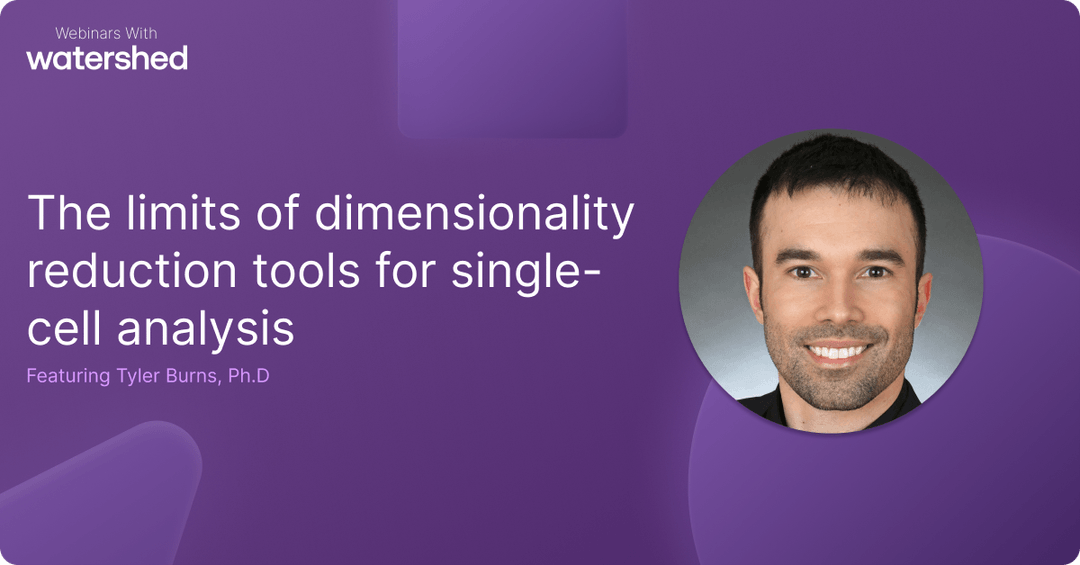
The limits of dimensionality reduction tools for single-cell analysis
Learn how to visualize single-cell data and interrogate the outputs of dimensionality reduction tools like t-SNE and uMAP.
How can you use Watershed?
Join us for these upcoming conferences, webinars, and workshops.
What is Watershed?
Watershed is a modern operating system designed to fix the real bottlenecks in impactful bioinformatics. Watershed’s powerful hardware and intelligent software supports rather than replaces the bioinformatics developer by providing familiar, industry-standard coding tools, and getting out of the way of data-driven research and development. At the same time, our software layer provides single-button access to dedicated workhorse computers, scalable HPC environments, and industrial GPUs*, removing the need for a bioinformatician to moonlight as a cloud-ops engineer. Similarly, Watershed makes it effortless to convert analytical notebooks to UI-powered dashboards, letting dry-lab and wet-lab scientists collaborate on their data, and giving a first-class analytical experience to everyone on your team regardless of coding ability.
*not all access tiers have on-demand access to GPUs
Who uses Watershed?
Watershed is designed for any team where computational developers and wet-lab experts need to collaborate without barriers to either group. Our users include biologists, bioinformaticians, software engineers, and CSOs within discovery R&D groups, proteomics cores, sequencing facilities, informatics consulting orgs, and academic centers of excellence. The OS's flexibility makes it adaptable to a wide range of applications, but it shines for groups that need fast and robust computational workflows that don’t box out their wet-lab experts.
What does Watershed specialize in?
Watershed specializes in bioinformatician-friendly hardware and software working together. On the hardware side, our proprietary, purpose-built stack delivers informatics-focused (read: high-RAM, low-latency) machines with on-demand state-of-the-art GPUs without complex cloud-ops baggage wherever you need it. Meanwhile, our software focuses on effortless collaboration with non-coding colleagues and a workflow language that allows easy parallelization, HPC dispatch, caching, and tracking while seamlessly blending with unix tools and familiar notebook environments.
What sets your platform apart from others on the market?
Watershed is founded on the belief that bioinformatics developers are real scientists doing real science, and no software platform can ever replace them. Rather than offering a range of pre-existing “one-size-fits-all” software pipelines that try to remove the bioinformatician from bioinformatics and ultimately serve no research groups’ needs perfectly, Watershed exists to empower and support the bioinformatician in accessing the resources they need and giving them the tools to share their work in an impactful manner. At the same time, our focus on collaboration across coding levels is central to our belief that the best scientific teams are those where everyone’s expertise is valued, and every user is treated as a first-class contributor on an equal playing field.
How can I get started with Watershed?
Schedule a demo with us today! We’ll share some of the magic that makes Watershed special, find out more about your compute, data, & storage needs, and help find the best Watershed package for you.
Explore our latest research insights, read up on new computational tools, download case studies and much more.

Learn how to visualize single-cell data and interrogate the outputs of dimensionality reduction tools like t-SNE and uMAP.

AlphaFold2 predictions have been used to probe questions at the heart of biomedical research, like how to design superior drugs, and how protein structure impacts disease.

Violet Therapeutics is a pre-clinical stage company leveraging their first-in-class platform, based on RABID-seq technology, to map and mine the cellular connectome at scale.

A privately-held biotechnology company is developing a new category of gene therapies.

Geneformer is a tool developed by Theodoris et al. (Nature 2023) to predict tissue-specific gene network dynamics from single-cell transcriptomic data.

Compare WGS and WES data to reference genomes to identify and quantify variations.

Robustly identify indels, copy-number alterations, structural variants, and more.

Effectively utilize data from public sources like Open Targets, Genebass, gnomAD, CCLE, and dbSNP.

Perform phase-aware analyses of long-read data from PacBio or Oxford Nanopore.

Analyze data from BLISS, GUIDE-Seq, CRISPResso, Digenome-Seq, and other techniques to characterize on-target efficacy and off-target profiles.